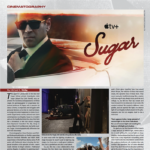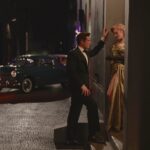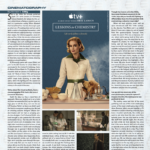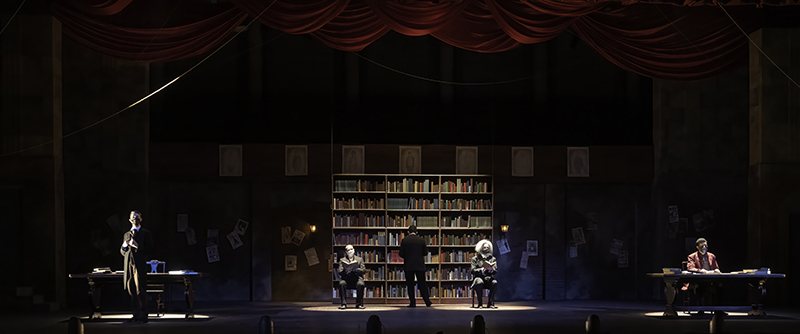
Silence fell across opera departments at the world’s most prestigious music schools in March 2020. Instead of rehearsing live operas chosen to showcase the next generation of professional singers, students quarantined in dormitories or headed how me for socially distanced learning, knowing that the roles they expected to play in staged productions would not take place. For graduating seniors at the University of Rochester’s Eastman School of Music, the opportunity to play Mrs. Lovett, Joanna, or Anthony in the spring production of Sweeney Todd evaporated, and the ornate, 1,500-seat Kodak Hall stood empty.
Worse, as the fall 2020 semester approached, the university handed down rules dictated by the State of New York: Singing was a “super-spreader event,” so no one could be in the same room with a performing opera singer — not even an accompanist, much less a cast, director, designers, or crew. A student could sing alone in a room, but only for 30 minutes, and then the room had to be vacated completely for another 30 minutes before anyone else could enter. Even then, just two crew members wearing personal protective equipment could enter the room to wipe down anything in the path of a singer’s powerful exhalation.
Most opera departments simply cancelled their planned productions and sent their students home. But Steven Daigle, professor of opera and artistic director for Eastman Opera Theatre, resisted taking the easy way out.
“We were all looking at engaging some creativity in a moment that was very stagnant,” said Daigle. “We’re in an environment where we’re trying to advance the students. This forced us to rethink how we rehearsed and prepared the students for what they will encounter in professional companies.”
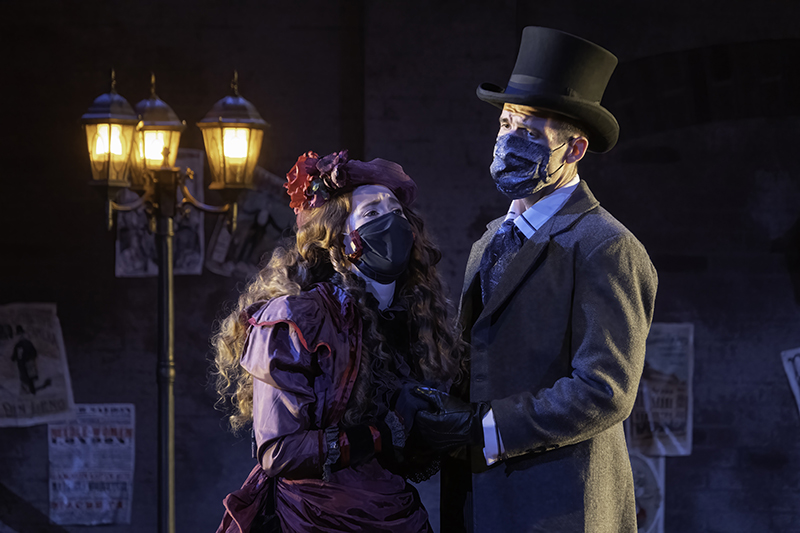
In-Person to Video
Daigle and Stephen Carr, associate professor of opera and musical theatre at Eastman, decided to abandon their mutual comfort zone and venture into a realm neither of them had experienced before: They moved their entire 2020-2021 season to video. As it became clear that they could not stage an entire production and simply capture it digitally, they learned how to make movies — recording the music in advance and shooting out of sequence to capture individual students’ performances.
“The stakes were high for us, because we thought the film versions would be like the ones at the Metropolitan Opera, where they capture a live performance,” said Daigle. “We decided to make them more like an actual film.”
This required a massive shift in technical requirements, as the department owned only the most minimal video production technology. Luckily, technical director Mark Houser and resident lighting designer Nic Minetor both had video and film production experience and knew what would be required. Houser came to Eastman via CMI Communications, where he had worked in corporate video and projections, while Minetor served as a gaffer on commercials, Kodak and Xerox film shoots, and for 14 years as the lighting director for the PBS series “Second Opinion.” (Full disclosure: Nic is my husband.)
“When we started talking about video, I knew a little bit about Blackmagic cameras and video production semi-pro products,” said Houser. “I reached out to B&H in New York City on what they would suggest. I ended up buying cameras from PTZ Optics, because they can be operated remotely.”
Remote operation became critical even as some of the restrictions began to lift in spring 2021, because technicians still could not be in the same room as the singers. The PTZ Optics SDI cameras Houser chose provided both HDMI and SDI output options, giving Houser the option of higher quality images if he should need broadcast quality for future productions.
For switching, Houser selected Blackmagic’s ATEM Mini-Pro ISO, which can record video to USB disks in H.264 format. This switcher features a built-in streaming engine compatible with YouTube Live, Facebook, Twitch, and other platforms, as well as the ability to see the picture from all of the cameras on a single monitor. The Mini-Pro ISO can record five streams from multiple cameras, providing clean feeds of all of the inputs, and it can save projects in RAW format for higher quality finishing. It also came at an affordable price point.
“It had to be a pan-tilt-zoom camera that could be controlled from another location, because we couldn’t be in the same room,” said Houser. “I taught MaryPat Frohm on my crew how to do switching and set up the cameras. The picture quality was excellent, and latency was very minimal when we were live.”
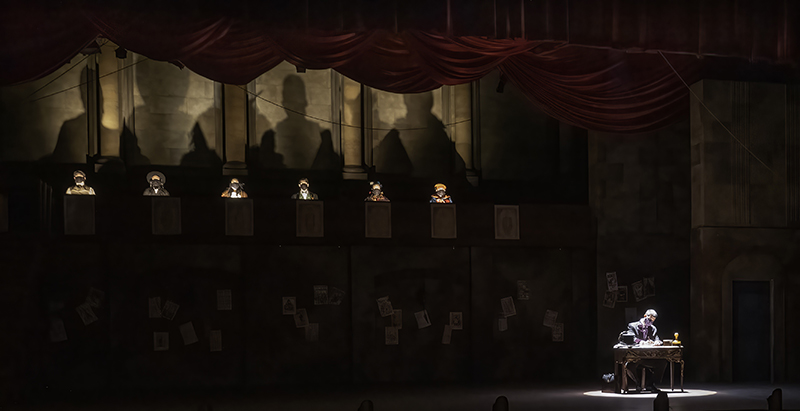
Zoom Meetings and Greenscreens
For the season’s first production, Our Voices, Daigle constructed a song cycle featuring six living composers, and engaged the composers with the students through Zoom meetings. The singers had the opportunity to ask questions of the composers about the work they would present in the performances. For each set of pieces, a lone singer performed in front of a greenscreen as images and video selected by set designers C. Murdock Lucas and Daniel Hobbs provided a sense of place.
“We had to pre-record all the orchestra,” said Houser. “The music was piped in to the singers, and then we did record them singing live in the hall.”
The second production, Dominic Argento’s Postcard from Morocco, moved the company’s video capabilities forward significantly. While Our Voices featured many individual songs, Postcard had a plot and characters, opening the door to something closer to movie production. The singers had to pre-record the music with orchestra, however, so they could wear masks and lip-sync onstage, much as they might in a movie musical. Meanwhile, the directors focused keenly on the singers’ acting — making sure that they looked as though they were singing live, with the proper breathing and expression.
“I learned a lot from Nic about lighting needs, especially when there’s a greenscreen involved,” said Carr. “I didn’t know that the way it looks in person or even on a monitor is not the way it will look in the end.”
Working with greenscreen backgrounds in a theatrical setting made for some unusual challenges, said Minetor. “You have to support the technology — have everything lit to a specification — but the lighting still has to support the story as well. So it’s art and science. I had to ask Stephen to trust my experience with the technology, knowing that it looks different live from how it will look in post.”
A stage director with international credits, Carr was a complete newbie to film production, in which shooting all of the scenes on one set or in one location takes precedence over following the story line. As the department moved into its largest production of the year — the murder mystery opera Elizabeth Cree, which has 29 different scenes on several sets — Carr struggled to learn the new skill of shooting out of sequence.
“I just don’t have that kind of brain,” he said. “When you rehearse and direct in sequence, you find things that you keep and that inform the story. But shooting out of sequence, you have to have the macro picture in your mind in a different way. On the other hand, it allowed us to make small changes in one scene to show that time had passed, a luxury you don’t have when you have 10 seconds to move the set on and off before the next scene. It was especially tricky.”
Carr noted that he owed a debt of gratitude to Eastman’s unflappable stage manager, Joshua Lau, whose ability to keep the convoluted production on schedule amazed all of the directors. “Josh is the hero — he’s got this preternatural calm,” he said. “He can make the most insurmountable task feel okay.”
With the performances captured on video, the task still in progress for Postcard and Elizabeth Cree is the editing — and Daigle took it upon himself to learn Final Cut Pro and become a video editor, an extension of his work as artistic director for Ohio Light Opera, where he edits more conventional videos of stage productions. “I used a lot of YouTube tutorials and became familiar enough with it to feel that I could do it fairly quickly,” he said. “On Elizabeth Cree, we’re through 20 or 25 versions so far, so I’m guessing I’ve spent about 80 hours at the computer to put this together.” The finished product will appear online on the Eastman School of Music’s YouTube channel in August.

A Unique Learning Experience
Paramount in everyone’s mind, Daigle emphasized, is that the students had a unique experience they would never have had in a normal year.
“One of the comments that has come back to a lot of the opera faculty is that the other schools aren’t doing anything,” he said. “This is such an unsettling time to be doing something creative. But it’s kind of glamorous for the students to be doing a film shoot instead of being onstage.”
Singers also had the opportunity to record their voices with an orchestra in a studio setting — something most professional opera singers do not experience until later in their careers. “Being able to work with a conductor and a live orchestra, that’s something they will feel a little more comfortable with now,” Daigle said. “It’s now on audio, and it’s their voice, and that’s a higher level than they would normally have.”
Carr summed up the year by quoting a haiku by Mizuta Masahide: Since my barn burned down/I now own a better view/of the rising moon. “We are standing in the embers of what we used to be,” he said, “and now we get to decide what kind of barn we want to build.”
Chances are, it will be one with carefully selected camera positions.
Randi Minetor is a freelance journalist and author based in upstate New York.
